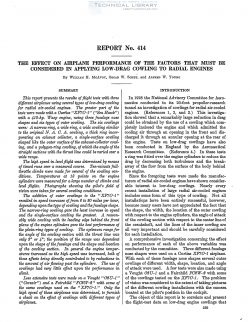naca-report-414

- Version
- 205 Downloads
- 1.25 MB File Size
- 1 File Count
- August 26, 2016 Create Date
- August 26, 2016 Last Updated
National Advisory Committee for Aeronautics, Report - The Effect on Airplane Performance of the Factors that Must Be Considered in Applying Low Drag Cowling to Radial Engines

This report presents the results offlight tests with three
difl'erent airplanes using several types of low—drag cowling
for radial air-cooled engines. The greater part of the
tests were made with a Oztrtiss “XF'70— ” (“Sea Hawk”)
with a 410-hp. Wasp engine, using three fuselage nose
shapes and sia: types of outer cowling. The site cowlings
were: A narrow ring, a wide ring, a wide cowling similar
to the original N. A. 0. A. cowling, a thick ring incor-
porating an exhaust collector, a single—surface cowling
shaped like the outer surface of the etchaust—collector cowl-
ing, and a polygon-ring cowling, of which the angle of the
straight sections with the thrust line could be varied over a
wide range.
The high speed in level flight was determined by means
of timed runs over a measured course. Ten-minute full-
throttle climbs were made for several of the cowling con-
ditions. Temperatures at 18 points on the 'engine
cylinders were measured for a large number of climbs and
level flights. Photographs showing the pilot’s field of
vision were taken for several cowling conditions.
The addition of outer cowlings to the “XF7’0—1 ”
resulted in speed increases of from 6 to 20 miles per hour,
depending upon the type of cowling and the fuselage shape.
The narrow-ring cowling gave the least increase in speed
and the single-surface cowling the greatest. A reason-
ably wide cowling with its leading edge behind the front
plane of the engine cylinders gave the best performance of
the plainaing types of cowling. The optimum range for
the angle of the cowling section with the thrust line was
only 3° or 4°; the position of the range was dependent
upon the shape of the fuselage and the shape and location
of the cowling section. In general the engine temper—
atures increased as the high speed was increased, both of
these ejects being directly contributed to by reductions in
the amount of air flowing past the cylinders. The use of
cowlings had very little efiect upon the pedormance in
climb.
| File | Action |
|---|---|
| naca-report-414 The Effect on Airplane Performance of the Factors that Must Be Considered in Applying Low Drag Cowling to Radial Engines.pdf | Download |

Comment On This Post